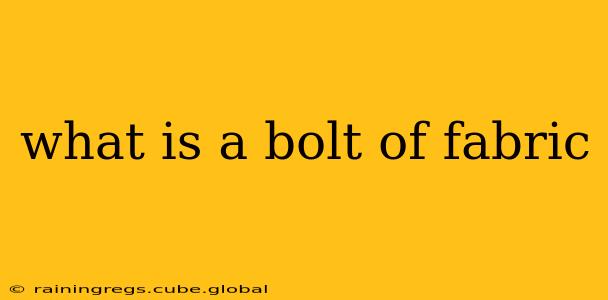A bolt of fabric, also known as a roll of fabric, is a large, continuous length of fabric rolled onto a cardboard tube. It's the way fabric is typically sold wholesale to retailers, manufacturers, and quilters. Understanding bolts is crucial whether you're a seasoned sewer or just starting your crafting journey. This guide will delve into the specifics of fabric bolts, addressing common questions and misconceptions.
What is the standard width of a bolt of fabric?
The standard width of a bolt of fabric varies depending on the type of fabric and the manufacturer. However, common widths include 45 inches (114 cm) and 60 inches (152 cm). You'll often see narrower widths for specialty fabrics or those with unique weaves. It's always best to check the product description before purchasing to avoid unexpected surprises.
How much fabric is on a bolt?
The length of fabric on a bolt varies significantly. A typical bolt can contain anywhere from 25 to 100 yards (23 to 91 meters), or even more, depending on the fabric type and the retailer's order. Larger bolts are more common in wholesale settings, whereas smaller bolts, sometimes referred to as "cuts," might be found in retail stores.
What are bolts of fabric used for?
Bolts of fabric are the lifeblood of the textile industry. They're essential for:
- Garment Manufacturing: Clothing manufacturers use bolts to produce large quantities of clothing items.
- Home Decor: Bolts provide the raw materials for curtains, bedding, upholstery, and other home goods.
- Quilting: Quilters purchase bolts of various fabrics to create intricate and large-scale projects.
- Craft Projects: From smaller sewing projects to large-scale installations, bolts offer a wide array of options.
How much does a bolt of fabric cost?
The price of a fabric bolt is dependent on numerous factors, including:
- Fabric type: Natural fibers like silk or linen are typically more expensive than synthetics such as polyester or nylon.
- Fabric quality: Higher quality fabrics, with finer weaves and more durable construction, command higher prices.
- Quantity: Larger bolts usually cost less per yard than smaller quantities.
- Supplier: Different suppliers have different pricing strategies.
It's impossible to give a single price; however, you can expect significant price variation based on the above considerations.
What is the difference between a bolt and a cut of fabric?
The key difference lies in quantity. A bolt represents a large, continuous roll of fabric, while a cut is a smaller, pre-cut piece from a bolt. Cuts are often sold by the yard or meter in retail settings, offering consumers more manageable quantities.
Where can I buy bolts of fabric?
Bolts of fabric can typically be purchased from:
- Wholesale fabric distributors: These companies specialize in supplying large quantities of fabric to businesses.
- Fabric stores: Many fabric stores offer a selection of bolts, particularly those catering to quilters and garment makers.
- Online retailers: A growing number of online retailers sell fabric bolts, often offering a wider variety and competitive prices.
Understanding the nuances of fabric bolts can significantly enhance your fabric-buying experience, whether you are a seasoned professional or a passionate hobbyist. Remember to always clarify the width, length, and price before making a purchase.
